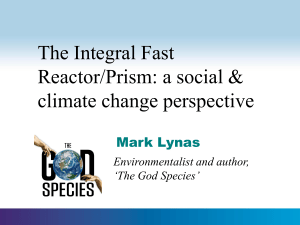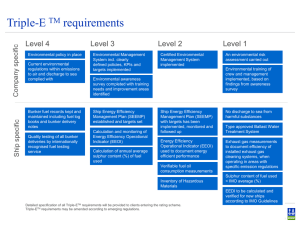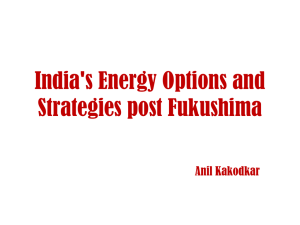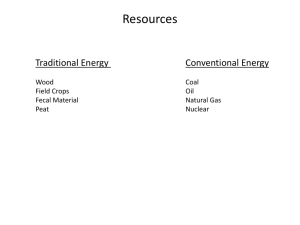Waste Management in the Nuclear Fuel Cycle
advertisement
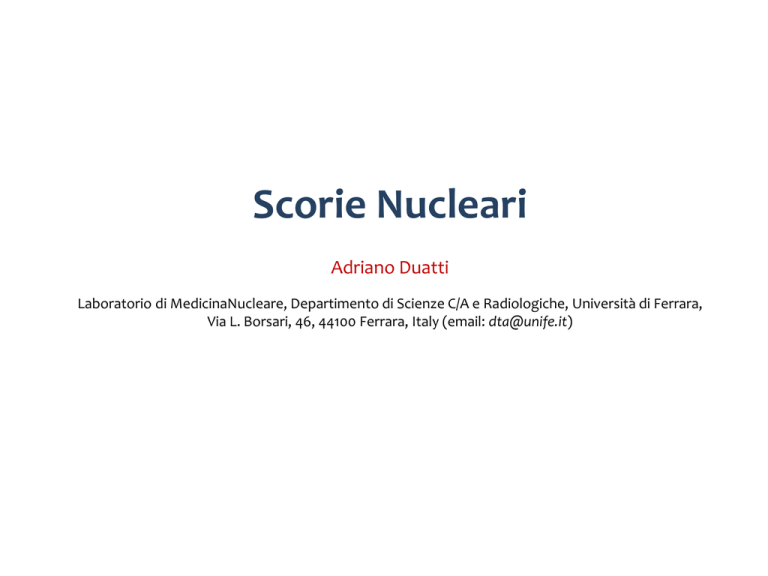
Scorie Nucleari Adriano Duatti Laboratorio di MedicinaNucleare, Departimento di Scienze C/A e Radiologiche, Università di Ferrara, Via L. Borsari, 46, 44100 Ferrara, Italy (email: dta@unife.it) Sources of waste Radioactive waste comes from a number of sources. The majority of waste originates from the nuclear fuel cycle and nuclear weapons reprocessing. However, other sources include medical and industrial wastes, as well as naturally occurring radioactive materials (NORM) that can be concentrated as a result of the processing or consumption of coal, oil and gas, and some minerals. Classification of radioactive wastes Low-level waste (LLW): contains enough radioactive material to require action for the protection of people, but not so much that it requires shielding in handling or storage. Intermediate-level waste (ILW): requires shielding. If it has more than 4000 Bq/g of long-lived (over 30 year half-life) alpha emitters it is categorised as "long-lived" and requires more sophisticated handling and disposal. High-level waste (HLW): sufficiently radioactive to require both shielding and cooling, generates >2 kW/m3 of heat and has a high level of long-lived alpha-emitting isotopes. Very low level waste or exempt waste: these categories contain negligible amount amounts of radioactivity and may be disposed of with domestic refuse. Low-level Waste Comprises the bulk of waste from the nuclear fuel cycle. It comprises paper, rags, tools, clothing, filters etc which contain small amounts of mostly short-lived radioactivity. It does not require shielding during handling and transport and is suitable for shallow land burial. To reduce its volume, these wastes are often compacted or incinerated before disposal. Disposal sites for low level waste are in operation in many countries. Worldwide they make up 90% of the volume but have only 1% of the total radioactivity of all radioactive wastes. Intermediate-level Waste Contains higher amounts of radioactivity and normally requires shielding. Shielding can be barriers of lead, concrete or water to give protection from penetrating radiation such as gamma rays. Intermediate-level wastes typically comprise resins, chemical sludges and metal fuel cladding, as well as contaminated materials from reactor decommissioning. It may be solidified in concrete or bitumen for disposal. Generally short-lived waste (mainly from reactors) is buried, but long-lived waste (from fuel reprocessing) will be disposed of underground. High-level Waste Contains the fission products and transuranic elements generated in the reactor core which are highly radioactive and hot. High-level waste accounts for over 95% of the total radioactivity produced though the actual amount of material is low, 25-30 tonnes of spent fuel or three cubic metres per year of vitrified waste for a typical large nuclear reactor (1000 MWe, light-water type). Radioactive medical source Contain beta particle and gamma ray emitters. It can be divided into two main classes. In diagnostic nuclear medicine a number of short-lived gamma emitters such as technetium-99m are used. Many of these can be disposed of by leaving it to decay for a short time before disposal as normal waste. Other isotopes used in medicine, with half-lives in parentheses: Y-90, used for treating lymphoma (2.7 days) I-131, used for thyroid function tests and for treating thyroid cancer (8.0 days) Sr-89, used for treating bone cancer, intravenous injection (52 days) Ir-192, used for brachytherapy (74 days) Co-60, used for brachytherapy and external radiotherapy (5.3 years) Cs-137, used for brachytherapy, external radiotherapy (30 years) Other low-level sources Industrial source waste can contain alpha, beta, neutron or gamma emitters. Gamma emitters are used in radiography while neutron emitting sources are used in a range of applications, such as oil well logging. Naturally occurring radioactive material (NORM) contains alpha particleemitting matter from the decay chains of uranium and thorium. The main source of radiation in the human body is potassium-40 (40K). There is a natural background radioactivity that life systems are built to resist. Most rocks, due to their components, have a certain, but low level, of radioactivity. Coal contains a small amount of radioactive uranium, barium, thorium and potassium. However, a coal power plant releases 100 times as much radiation as a nuclear power plant of the same wattage. It is estimated that during 1982, US coal burning released 155 times as much radioactivity into the atmosphere as the Three Mile Island accident. The Nuclear Fuel Cycle The nuclear fuel cycle is the series of industrial processes which involve the production of electricity from uranium in nuclear power reactors. Uranium is a relatively common element that is found throughout the world. It is mined in a number of countries and must be processed before it can be used as fuel for a nuclear reactor. Fuel removed from a reactor, after it has reached the end of its useful life, can be reprocessed to produce new fuel. The Nuclear Fuel Cycle Fuel Production Uranium dioxide (UO2) concentrate from mining is not very radioactive - only a thousand or so times as radioactive as the granite used in buildings. It is refined from yellowcake (U3O8), then converted to uranium hexafluoride gas (UF6). As a gas, it undergoes enrichment to increase the U-235 content from 0.7% to about 4.4% (LEU). It is then turned into a hard ceramic oxide (UO2) for assembly as reactor fuel elements. Uranium fuel Uraninite (Pitchblende) Yellowcake U3O8 UO2 Uranium fuel UF6 Fuel rods (UO2) Reaction in standard UO2 fuel Fission products Fission product yields by mass for thermal neutron fission of U-235, Pu-239, and U-233 used in the thorium cycle Fission products About 3% of the mass consists of fission products of 235U and 239Pu and products in the decay chain. The fission products include every element from zinc through to the lanthanides, much of the fission yield is concentrated in two peaks, one in the second transition row (Zr, Mo, Tc, Ru, Rh, Pd, Ag) while the other is later in the periodic table (I, Xe, Cs, Ba, La, Ce, Nd). Many of the fission products are either non radioactive or only shortly lived radioisotopes. But a considerable number are medium to long lived radioisotopes such as 90Sr, 137Cs, 99Tc and 129I. Medium-lived fission products Nuclide T1/2, y Yield ,% E, keV 155Eu 4.76 0.0803 252 58Kr 10.76 0.2180 687 113mCd 14.1 0.0008 316 90Sr 28.9 4.505 2826 137Cs 30.23 6.337 1176 121mSn 43.9 0.00005 390 151Sm 90 0.5314 77 Long-lived fission products Nuclide T1/2, My Yield ,% E, keV 99mTc 0.211 6.1385 294 126Sn 0.230 0.1084 4050 79Se 0.295 0.0447 151 93Zr 1.53 5.4575 91 135Cs 2. 3 6.9110 269 107Pd 6.5 1.2499 33 129I 15.7 0.8410 194 ‘Front End’ Waste Waste from the front end of the nuclear fuel cycle is usually alpha emitting waste from the extraction of uranium. It often contains radium and its decay products. The main by-product of enrichment is depleted uranium (DU), principally the U-238 isotope, with a U-235 content of 0.3%. It is stored, either as UF6 or as U3O8. ‘Back End’ Waste The back end of the nuclear fuel cycle, mostly spent fuel rods, contains fission products that emit beta and gamma radiation, and actinides that emit alpha particles, such as uranium-234, neptunium-237, plutonium-238 and americium-241, and even sometimes some neutron emitters such as californium (Cf). These isotopes are formed in nuclear reactors. Annual operation of a 1000 MWe nuclear power reactor Mining 20,000 tonnes of 1% uranium ore Milling 230 tonnes of uranium oxide concentrate (which contains 195 tonnes of uranium) Conversion 288 tonnes uranium hexafluoride, UF6 (with 195 t U) Enrichment 35 tonnes enriched UF6 (containing 24 t enriched U) Fuel fabrication 27 tonnes UO2 (with 24 t enriched U) Reactor operation 8640 million kWh (8.64 TWh) of electricity at full output Used fuel 27 tonnes containing 240 kg plutonium, 23 t uranium (0.8% U-235), 720kg fission products, also transuranics. A typical reactor generates about 27 tonnes of spent fuel or 3 m3 per year of vitrified waste Decay in radioactivity of fission fuel in one tonne of spent fuel Storage in ponds at reactor sites There are about 270,000 tonnes of used fuel in storage, much of it at reactor sites. About 90% of this is in storage ponds, the balance in dry storage. Annual arisings of used fuel are about 12,000 tonnes, and 3,000 tonnes of this goes for reprocessing. Final disposal is not urgent in any logistical sense Waste Management in the Nuclear Fuel Cycle Minimise the volume of waste requiring management via treatment processes. Reduce the potential hazard of the waste by conditioning it into a stable solid form that immobilises it and provides containment to ensure that the waste can be safely handled during transportation, storage and final disposal. Identifying a suitable matrix material - such as cement, bitumen, polymers or borosilicate glass - that will ensure stability of the radioactive materials for the period necessary. The type of waste being conditioned determines the choice of matrix material and packaging. Immobilising the waste through mixing with the matrix material. Packaging the immobilised waste in, for example, metallic drums, metallic or concrete boxes or containers, copper canisters. Waste Management in the Nuclear Fuel Cycle: LLW and ILW The intermediate-level waste (ILW) along with the low-level waste represent some 90% of the total volume of radioactive waste generated during the lifetime of a nuclear power plant. This relatively large volume of long-lived and short-lived ILW contains only about 1% of the total radioactivity. Only a small proportion of the intermediate-level waste remains significantly radioactive for years, but all ILW requires shielding when it is handled. Waste Management in the Nuclear Fuel Cycle: LLW Incineration This technique can be applied to both radioactive and other wastes. In the case of radioactive waste, it has been used for the treatment of lowlevel waste from nuclear power plants, fuel production facilities, research centres (such as biomedical research), medical sector and waste treatment facilities. Following the segregation of combustible waste from non-combustible constituents, the waste is incinerated in a specially engineered kiln up to around 1000 °C. Any gases produced during incineration are treated and filtered prior to emission into the atmosphere and must conform to international standards and national emissions regulations. Volume reduction factors of up to around 100 are achieved, depending on the density of the waste. Waste Management in the Nuclear Fuel Cycle: ILW Compaction and Cementation Cementation Compaction Waste Management in the Nuclear Fuel Cycle: LLW Disposal Near-surface disposal facilities at ground level. These facilities are on or below the surface where the protective covering is of the order of a few metres thick. Waste containers are placed in constructed vaults and when full the vaults are backfilled. Eventually they will be covered and capped with an impermeable membrane and topsoil. These facilities may incorporate some form of drainage and possibly a gas venting system. Near-surface disposal facilities in caverns below ground level. Unlike near-surface disposal at ground level where the excavations are conducted from the surface, shallow disposal requires underground excavation of caverns but the facility is at a depth of several tens of metres below the Earth's surface and accessed through a drift. Waste Management in the Nuclear Fuel Cycle: HLW Immobilise waste in an insoluble matrix such as borosilicate glass or synthetic rock (fuel pellets are already a very stable ceramic: UO2). Seal it inside a corrosion-resistant container, such as stainless steel. Locate it deep underground in a stable rock structure. Surround containers with an impermeable backfill such as bentonite clay if the repository is wet. Waste Management in the Nuclear Fuel Cycle: HLW Vitrification The first step in the waste vitrification process involves calcination involves passing the waste through a heated, rotating tube. The purposes of calcination are to evaporate the water from the waste, and de-nitrate the fission products to assist the stability of the glass produced. The 'calcine' generated is fed continuously into an induction heated furnace with fragmented glass[27]. The resulting glass is a new substance in which the waste products are bonded into the glass matrix when it solidifies. This product, as a molten fluid, is poured into stainless steel cylindrical containers ("cylinders") in a batch process. When cooled, the fluid solidifies ("vitrifies") into the glass. Such glass, after being formed, is very highly resistant to water. A typical reactor generates about 27 tonnes of spent fuel or 3 m3 per year of vitrified waste. Vitrification Typical Storage Container for Spent Fuel Waste Management in the Nuclear Fuel Cycle: HLW The Synroc method Synroc is composed of three titanate minerals – hollandite, zirconite and perovskite – plus rutile and a small amount of metal alloy. These are combined into a slurry to which is added a portion of high-level liquid nuclear waste. The mixture is dried, calcined at 750 °C to produce a powder, and then compressed in a bellows-like stainless steel container at temperatures of between 1150 and 1200 °C. The result is a cylinder of hard, dense, black synthetic rock. Unlike borosilicate glass, which is amorphous, Synroc is a ceramic that incorporates the radioactive waste into its crystal structure Waste Management in the Nuclear Fuel Cycle: HLW Disposal Geological repositories are planned in stable rock formations in the main countries utilising nuclear energy. It is the responsibility of each country to dispose of its wastes. Typically a repository will be 500 metres down in rock, clay or salt. The disposing strategy is a multiple barrier concept: The waste, either as a ceramic oxide (e.g. the spent fuel itself) or through vitrification (separated HLW from reprocessing) is immobilised. It is then sealed in a corrosion resistant canister such as stainless steel or copper. Finally it is buried in a solid rock formation. Waste Management in the Nuclear Fuel Cycle: HLW Disposal in strong fractured rocks Disposal in clay Disposal in natural rock salt Disposal in outer space Disposal at a subduction zone Disposal at sea Sub seabed disposal Disposal in ice sheets Waste Management in the Nuclear Fuel Cycle: HLW The Oklo natural reactor A natural nuclear reactor was discovered in 1972 at the Oklo uranium mine in the West African republic of Gabon. The deposit of ore, which contained about 3% U-235, began a self-sustaining chain reaction millions of years ago. Like all reactors, this one created its own high-level waste, up to 5000 kg of fission products and transuranic elements which today are found only in used fuel. The Oklo chain reaction occurred intermittently for more than 500,000 years. Despite its location in a wet, tropical climate, Oklo's uranium deposit and high-level waste has remained securely locked in this natural repository for the past 2 million years. Many of the waste products stayed where they were created or moved only a few centimetres before decaying into harmless products. Reprocessing and Recycling Fresh uranium oxide fuel contains up to 5% U-235. When the fuel reaches the end of its useful life, it is removed from the reactor. At this point it typically contains about 95% U-238, 3% fission products (the residues of the fission reactions) and transuranic isotopes, 1% plutonium and 1% U235. The plutonium is produced by the neutron irradiation of U-238. Spent fuel still contains about a quarter of the original fissile U-235 as well as much of the plutonium which has been formed in the reactor. Reprocessing separates out this uranium and plutonium. The wastes left after reprocessing can then be disposed of, while the uranium and plutonium may be recycled for use in a nuclear reactor as mixed oxide (MOX) fuel. Decay in radioactivity of high-level waste after recycling one tonne of spent fuel Reprocessing and Recycling Plutonium is recycled through a special fuel fabrication plant to produce mixed oxide (MOX) fuel. MOX fuel is a mixture of plutonium and uranium oxides (formed from natural, depleted or reprocessed uranium). MOX fuel containing 5 to 7% plutonium has characteristics that are similar to uranium oxide based fuel and used as part of a reactor's fuel loading. It should be noted that plutonium arising from the civil nuclear fuel cycle is not suitable for bombs because it contains far too much of the Pu-240 isotope, due to the length of time the fuel has been in the reactor. Uranium from reprocessing, sometimes referred to as Rep-U, must usually be enriched, and to facilitate this it must first be converted to UF6. Reprocessing: the PUREX method PUREX is an acronym standing for Plutonium and Uranium Recovery by EXtraction. Essentially, it is a liquid-liquid extraction ion-exchange method. The irradiated fuel is first dissolved into nitric acid. An organic solvent composed of 30% tributyl phosphate (TBP) in odorless kerosene (or hydrogenated propylene trimer) is used to recover the uranium and plutonium; the fission products remain in the aqueous nitric phase. Once separated from the fission products, further processing allows separation of the heavier plutonium from the uranium. Reprocessing and Recycling MOX This type of nuclear fuel can be made by grinding together reprocessed uranium oxide (UO2) and plutonium oxide (PuO2) before the mixed oxide is pressed into pellets. MOX fuel, consisting of 7% plutonium mixed with depleted uranium, is equivalent to uranium oxide fuel enriched to about 4.5% U-235, assuming that the plutonium has about 60- 65% Pu-239. Reaction in MOX fuel International organisations and safety standards In 1997, 'The Joint Convention on the Safety of Spent Fuel Management and the Safety of Radioactive Waste Management' was adopted by a diplomatic conference of the International Atomic Energy Agency (IAEA). IAEA is the international organisation that oversees the peaceful uses of atomic energy. It is an agency of the United Nations, that is based in Vienna, Austria and was founded in 1957. The IAEA develops safety standards, guidelines and recommendations and provides technical guidance to member states regarding radiological practices and protection. The IAEA'S Waste Safety Section works to co-ordinate the development of internationally agreed standards on the safety of radioactive waste. The OECD/NEA (Nuclear Energy Agency of the Organisation for Economic Co-operation and Development) is based in Paris, France.

